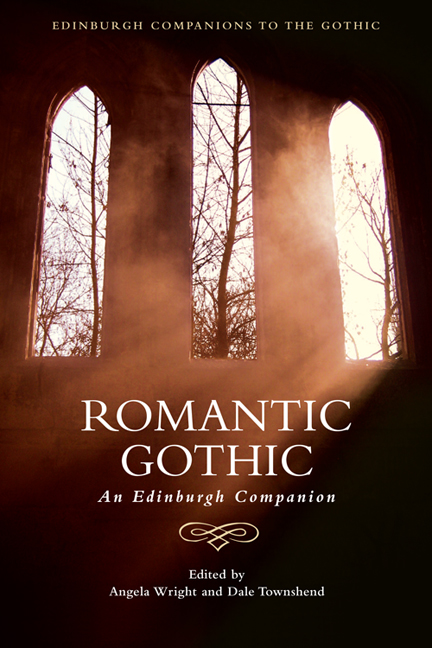Book contents
- Frontmatter
- Contents
- 1 Gothic and Romantic: An Historical Overview
- Part I Gothic Modes and Forms
- 2 Graveyard Writing and the Rise of the Gothic
- 3 Gothic Romance
- 4 The Gothic Stage: Visions of Instability, Performances of Anxiety
- 5 Gothic Poetry and First-Generation Romanticism
- 6 Gothic and Second-Generation Romanticism: Lord Byron, P. B. Shelley, John Polidori and Mary Shelley
- 7 Political Gothic Fiction
- 8 Shorter Gothic Fictions: Ballads and Chapbooks, Tales and Fragments
- 9 Oriental Gothic
- 10 Gothic Parody
- Part II National and International Borders
- Part III Reading the Romantic Gothic
- Notes on Contributors
- Index
2 - Graveyard Writing and the Rise of the Gothic
from Part I - Gothic Modes and Forms
Published online by Cambridge University Press: 05 August 2016
- Frontmatter
- Contents
- 1 Gothic and Romantic: An Historical Overview
- Part I Gothic Modes and Forms
- 2 Graveyard Writing and the Rise of the Gothic
- 3 Gothic Romance
- 4 The Gothic Stage: Visions of Instability, Performances of Anxiety
- 5 Gothic Poetry and First-Generation Romanticism
- 6 Gothic and Second-Generation Romanticism: Lord Byron, P. B. Shelley, John Polidori and Mary Shelley
- 7 Political Gothic Fiction
- 8 Shorter Gothic Fictions: Ballads and Chapbooks, Tales and Fragments
- 9 Oriental Gothic
- 10 Gothic Parody
- Part II National and International Borders
- Part III Reading the Romantic Gothic
- Notes on Contributors
- Index
Summary
Shortly before she died in 1800, the poet and novelist Mary Robinson reframed her life with some Gothic mythmaking. Picturing her birth in a ‘Minster-house’ attached to Bristol Cathedral, she describes a ‘tempestuous night’ during which ‘the wind whistled round the dark pinnacles of the minister tower, and the rain beat in torrents against the casements of [my mother's] chamber’ (Robinson 1994: 18). In the course of her memoir Robinson presents herself as a suffering heroine who deserves our compassion, but her claim on victimhood demonstrates her command of the Gothic: she is the mistress of this form, not its helpless construct. Crucially, she links Gothicism to literary fluency:
As soon as I had learned to read, my great delight was that of learning epitaphs and monumental inscriptions. A story of melancholy import never failed to excite my attention; and, before I was seven years old, I could correctly repeat Pope's Lines to the Memory of an Unfortunate Lady; and Mason's Elegy on the Death of the beautiful Countess of Coventry; and many smaller poems on similar subjects. (Robinson 1994: 21–2; emphasis in original)
Robinson's recollections provide a useful guide to the poetic forms that helped shape early Gothic fiction. Although the bulk of this chapter will look at graveyard poetry, I want to start by unpicking some of the overlapping genres in Robinson's childhood reading. Doing so will establish the basic principle of my argument, which is that eighteenth-century poetry and the Gothic inhabit a shared discursive field where numerous strands intersect and cross over, sometimes running parallel, at other times diverging. Along the way I will analyse memorial texts, poems set in graveyards, poems about nightfall and mental disorder, and works that personify extreme emotions; I will also address the relationship between language and visual culture. The chapter will end by asking what the Gothic's debt to graveyard writing tells us about the social function of the novel.
Memorial Stones and Monuments
Although ‘epitaphs and monumental inscriptions’ are no longer popular reading matter, Robinson's memoir reminds us that the writers who forged Romanticism were raised on such materials.
- Type
- Chapter
- Information
- Romantic GothicAn Edinburgh Companion, pp. 37 - 54Publisher: Edinburgh University PressPrint publication year: 2015



